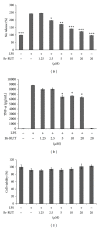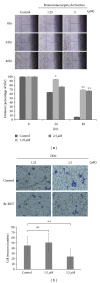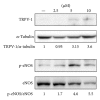Low-cytotoxic synthetic bromorutaecarpine exhibits anti-inflammation and activation of transient receptor potential vanilloid type 1 activities
- PMID: 24369537
- PMCID: PMC3863474
- DOI: 10.1155/2013/795095
Low-cytotoxic synthetic bromorutaecarpine exhibits anti-inflammation and activation of transient receptor potential vanilloid type 1 activities
Abstract
Rutaecarpine (RUT), the major bioactive ingredient isolated from the Chinese herb Evodia rutaecarpa, possesses a wide spectrum of biological activities, including anti-inflammation and preventing cardiovascular diseases. However, its high cytotoxicity hampers pharmaceutical development. We designed and synthesized a derivative of RUT, bromo-dimethoxyrutaecarpine (Br-RUT), which showed no cytotoxicity at 20 μM. Br-RUT suppressed nitric oxide (NO) production and tumor necrosis factor-α release in concentration-dependent (0~20 μM) manners in lipopolysaccharide (LPS)-treated RAW 264.7 macrophages; protein levels of inducible NO synthase (iNOS) and cyclooxygenase-2 induced by LPS were downregulated. Br-RUT inhibited cell migration and invasion of ovarian carcinoma A2780 cells with 0~48 h of treatment. Furthermore, Br-RUT enhanced the expression of transient receptor potential vanilloid type 1 and activated endothelial NOS in human aortic endothelial cells. These results suggest that the synthetic Br-RUT possesses very low cytotoxicity but retains its activities against inflammation and vasodilation that could be beneficial for cardiovascular disease therapeutics.
Figures





Similar articles
-
Synthetic Fluororutaecarpine Inhibits Inflammatory Stimuli and Activates Endothelial Transient Receptor Potential Vanilloid-Type 1.Molecules. 2017 Apr 19;22(4):656. doi: 10.3390/molecules22040656. Molecules. 2017. PMID: 28422079 Free PMC article.
-
Rutaecarpine Increases Nitric Oxide Synthesis via eNOS Phosphorylation by TRPV1-Dependent CaMKII and CaMKKβ/AMPK Signaling Pathway in Human Endothelial Cells.Int J Mol Sci. 2021 Aug 30;22(17):9407. doi: 10.3390/ijms22179407. Int J Mol Sci. 2021. PMID: 34502308 Free PMC article.
-
Anti-inflammatory effects and mechanisms of the ethanol extract of Evodia rutaecarpa and its bioactive components on neutrophils and microglial cells.Eur J Pharmacol. 2007 Jan 26;555(2-3):211-7. doi: 10.1016/j.ejphar.2006.10.002. Epub 2006 Oct 17. Eur J Pharmacol. 2007. PMID: 17109845
-
Rutaecarpine: A promising cardiovascular protective alkaloid from Evodia rutaecarpa (Wu Zhu Yu).Pharmacol Res. 2019 Mar;141:541-550. doi: 10.1016/j.phrs.2018.12.019. Epub 2019 Jan 4. Pharmacol Res. 2019. PMID: 30616017 Review.
-
Evodiamine and rutaecarpine from Tetradium ruticarpum in the treatment of liver diseases.Phytomedicine. 2020 Mar;68:153180. doi: 10.1016/j.phymed.2020.153180. Epub 2020 Feb 4. Phytomedicine. 2020. PMID: 32092638 Review.
Cited by
-
Synthetic Fluororutaecarpine Inhibits Inflammatory Stimuli and Activates Endothelial Transient Receptor Potential Vanilloid-Type 1.Molecules. 2017 Apr 19;22(4):656. doi: 10.3390/molecules22040656. Molecules. 2017. PMID: 28422079 Free PMC article.
-
Optimization of Rutaecarpine as ABCA1 Up-Regulator for Treating Atherosclerosis.ACS Med Chem Lett. 2014 Jun 24;5(8):884-8. doi: 10.1021/ml500131a. eCollection 2014 Aug 14. ACS Med Chem Lett. 2014. PMID: 25147608 Free PMC article.
-
Rutaecarpine attenuates hypoxia-induced right ventricular remodeling in rats.Naunyn Schmiedebergs Arch Pharmacol. 2016 Jul;389(7):757-67. doi: 10.1007/s00210-016-1240-8. Epub 2016 Apr 6. Naunyn Schmiedebergs Arch Pharmacol. 2016. PMID: 27052575
References
-
- Liu Y-N, Pan S-L, Liao C-H, et al. Evodiamine represses hypoxia-induced inflammatory proteins expression and hypoxia-inducible factor 1α accumulation in RAW264.7. Shock. 2009;32(3):263–269. - PubMed
-
- Chiou W-F, Chou C-J, Shum AY-C, Chen C-F. The vasorelaxant effect of evodiamine in rat isolated mesenteric arteries: mode of action. European Journal of Pharmacology. 1992;215(2-3):277–283. - PubMed
-
- Chiou W-F, Shum AY-C, Liao J-F, Chen C-F. Studies of the cellular mechanisms underlying the vasorelaxant effects of rutaecarpine, a bioactive component extracted from an herbal drug. Journal of Cardiovascular Pharmacology. 1997;29(4):490–498. - PubMed
Publication types
MeSH terms
Substances
LinkOut - more resources
Full Text Sources
Other Literature Sources
Research Materials

